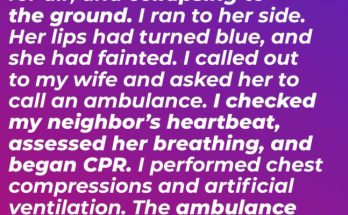While Cameron’s struggles were visible inside the school, someone else was quietly taking notice outside. Mr. Charles, a veteran bus driver with the Berkeley County School District, has spent decades ferrying children to and from school. He’s seen it all: the shy kids who barely speak, the class clowns who turn every ride into a comedy show, and the ones—like Cameron—who wear their hearts on their sleeves.
Every morning, Cameron was one of the first to board Bus 12. He’d shuffle down the aisle, head low, and take his seat by the window. Over the weeks, Mr. Charles noticed the boy’s frustration. Sometimes it was a muttered complaint, other times a tearful silence. He saw the way Cameron clenched his fists, the way he stared out the window as if willing the day to end before it began.
“I could tell something was off,” Mr. Charles recalls. “He just didn’t have that spark you see in most kids.”
A Simple Deal, A Big Change
One Friday morning, after another rough week for Cameron, Mr. Charles decided to try something different. As Cameron stepped onto the bus, Mr. Charles knelt down to meet him at eye level.
“I made him a deal,” Mr. Charles says. “If he could show good behavior during the week, I’d bring him a special treat every Friday.”
It was a simple promise—a small gesture from a man who understood that sometimes, kids need a reason to believe in themselves. For Cameron, it was the first glimmer of hope in months.
“I told him, ‘I believe in you. Let’s see what you can do,’” Mr. Charles remembers.
The change was almost immediate. With the promise of a treat on the horizon, Cameron began to try a little harder. He still had tough days, but the prospect of a reward—and the knowledge that someone cared enough to notice—gave him a new sense of purpose.
A Village Comes Together
As Cameron’s behavior improved, teachers and staff began to take notice. Stephanie Williams, his special education teacher, saw a new light in his eyes. She continued to escort him to the bus each afternoon, but now their walks were filled with chatter about the day’s successes.
“It was like he finally knew someone was rooting for him,” Williams says.
Kelly Eisenberg, too, noticed a shift at home. Cameron came through the door with stories of his day, eager to share his triumphs—however small. The principal’s office visits became less frequent. His meltdowns faded.
“Mr. Charles became a big part of our lives,” Kelly says. “He was the first person outside our family to really see Cameron for who he is.”
Beyond the Bus: Ice Cream, McDonald’s, and Baseball Games
The relationship between Cameron and Mr. Charles soon extended beyond the daily bus ride. On Fridays, Mr. Charles would bring Cameron a small treat—sometimes a bag of chips, sometimes a favorite snack. But he didn’t stop there.
He began taking Cameron out for ice cream after school. On weekends, he’d swing by the Eisenbergs’ home to take Cameron to McDonald’s or to cheer him on at his baseball games. He became a fixture in the stands, a quiet but powerful presence of encouragement.
“It wasn’t about the treats,” Kelly says. “It was about showing up. Cameron knew Mr. Charles cared.”
For Cameron, the impact was profound. He started to believe in himself, to see that he could be more than the kid who got sent to the principal’s office. He found stability in the routine, comfort in the friendship, and pride in his progress.
Unseen Heroes: The Power of a Bus Driver’s Kindness
In an age when schools are stretched thin and teachers are asked to do more with less, stories like Cameron and Mr. Charles’s are a reminder that the people who make the biggest difference in a child’s life aren’t always the ones at the front of the classroom. Sometimes, they’re waiting at the curb, behind the wheel of a bus, quietly watching and quietly caring.
Mr. Charles shrugs off the praise. “I just did what anyone would do,” he says. “Kids need someone in their corner.”
But for the Eisenbergs, and for the staff at Cane Bay Elementary, his actions were anything but ordinary. He saw a child in need and offered not just a reward, but a relationship—a steady hand in a world that often felt overwhelming.
A Mother’s Gratitude and a Boy’s New Beginning
Today, Cameron is a different child. He still has challenges, but he faces them with a newfound confidence. His principal’s office visits are rare. He’s made friends. He’s found joy in learning.
For Kelly Eisenberg, the relief is immeasurable. “I don’t know where we’d be without Mr. Charles,” she says. “He gave my son hope when we were running out of answers.”
Cameron, for his part, is quick to smile when asked about his friend. “He makes me feel happy,” he says simply.
The Lesson: Small Gestures, Big Impact
As the school year draws to a close, the story of Cameron and Mr. Charles has quietly spread through the halls of Cane Bay Elementary. Teachers share it with new staff. Parents whisper it to one another at pick-up. It’s a story about the power of noticing, of reaching out, of believing that every child is worth the effort.
For every Cameron, there are countless children struggling to fit in, to manage big feelings in a world that doesn’t always make sense. And for every Mr. Charles, there are unsung heroes whose small acts of kindness ripple outward, changing lives in ways they may never fully realize.
Sometimes, the person who makes the biggest difference isn’t the one with the lesson plan or the office on the corner. Sometimes, it’s the one who waits at the curb, day after day, ready to offer a smile, a promise, and a little bit of hope.

